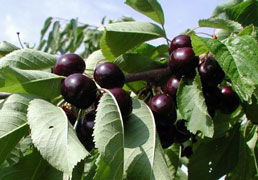


Home
Flowers &
Indoor Plants
Fruits & Nuts
Ornamentals
Vegetables
Special Topics
Resources
Glossary

 |
What about it? Cherries became popular in America in the early nineteenth century, thanks, in part to the efforts of John Chapman (Johnny Appleseed). Cherries are a type of tree fruit known as a stone fruit, as are peaches, plums, and apricots. What is it used for? Cherries are delicious and are used in baking, cooking, or fresh eating. Where does it grow? How do we grow it? Cherries are the very particular about site selection. They do best in deep rich loams. Good air and water drainage is necessary. Plant on a gentle slope to allow cold air to drain, protecting the trees from frost. Plant sweet cherries in rows that are 30 feet apart with 24 feet between each plant. Tart cherries (Prunus cerasus) should be planted in rows that are 24 feet apart with a spacing of 18 feet between plant Training and pruning will be necessary for good production. What are its primary problems? Cherries are susceptible to a fungus known as brown rot Valsa canker can be a problem too, along with several troublesome viruses. They are also prone to black knot, characterized by black, rough enlargements on the twigs. The most common insect found on cherry trees is the cherry maggot or the cherry fruit fly. Cherries are not an easy crop to grow for a number of reasons: 1) They are particularly attractive to birds, partly because they are one of the first fruits to ripen; 2) pollination is difficult, since they are self-incompatible and wet weather at flowering can also dramatically reduce set; 3) rain at or near harvest will cause fruit splitting; and 4) they are susceptible to difficult-to-control diseases. How do we harvest and store it? Cherries do not ripen after picking and need to be picked close to maturity. You can enjoy them fresh or make preserves. Only excellent quality fruit should be preserved. Many people feel that the taste of cherry pie is worth the trouble of growing cherries!
© Copyright, Department of Horticulture, Cornell University. |



